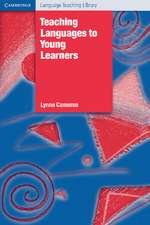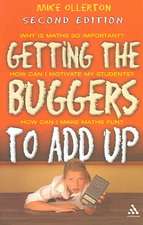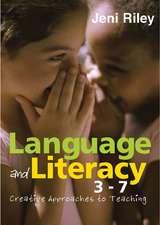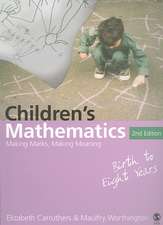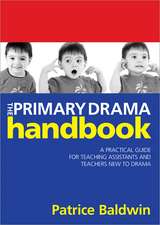Reading and Writing in Science: Tools to Develop Disciplinary Literacy
Autor Maria C. Grant, Douglas Fisher, Diane K. Lappen Limba Engleză Paperback – 6 apr 2015
Preț: 242.40 lei
Nou
Puncte Express: 364
Preț estimativ în valută:
46.39€ • 50.37$ • 38.97£
46.39€ • 50.37$ • 38.97£
Carte tipărită la comandă
Livrare economică 23 aprilie-07 mai
Preluare comenzi: 021 569.72.76
Specificații
ISBN-13: 9781483345680
ISBN-10: 1483345688
Pagini: 192
Dimensiuni: 178 x 254 x 18 mm
Greutate: 0.4 kg
Ediția:Second Edition
Editura: SAGE Publications
Colecția Corwin
Locul publicării:Thousand Oaks, United States
ISBN-10: 1483345688
Pagini: 192
Dimensiuni: 178 x 254 x 18 mm
Greutate: 0.4 kg
Ediția:Second Edition
Editura: SAGE Publications
Colecția Corwin
Locul publicării:Thousand Oaks, United States
Recenzii
“The authors of Reading and Writing in Science bring together expertise in Next Generation Science Standards, English language arts, and excellent teaching methods to produce an eminently readable guide for the novice and experienced teacher.
Teachers who wish to teach science while improving their students’ reading and writing skills will find a wealth of practical ideas in this volume.
The many practical ideas in this volume demonstrate that improving students’ skills in reading and writing can also improve their understanding and abilities in science.”
"Reading and Writing in Science is a teacher friendly book that drew me in from the introduction to the end. Through real life scenarios combined with useful methods for instruction, it illustrates how science teachers can use language as a tool for teaching science."
The real strength of the book is the almost equal weighting given to the four strands of literacy; oral, aural, reading and writing. This provides a useful prompt for the reader to go beyond the obvious when incorporating a greater literacy focus into their curriculum.
Teachers who wish to teach science while improving their students’ reading and writing skills will find a wealth of practical ideas in this volume.
The many practical ideas in this volume demonstrate that improving students’ skills in reading and writing can also improve their understanding and abilities in science.”
"Reading and Writing in Science is a teacher friendly book that drew me in from the introduction to the end. Through real life scenarios combined with useful methods for instruction, it illustrates how science teachers can use language as a tool for teaching science."
The real strength of the book is the almost equal weighting given to the four strands of literacy; oral, aural, reading and writing. This provides a useful prompt for the reader to go beyond the obvious when incorporating a greater literacy focus into their curriculum.
Cuprins
Introduction
New to This Edition
About the Authors
1. Teaching Students to Think Like Scientists
How Well Are U.S. Students Doing in Science?
What Foundations Do We Need to Have in Place?
What Are the Features of Purposeful Science Instruction?
What Do Real-World Scientists Do?
2. Knowing and Using Scientific Language to Communicate Like a Scientist
Language Is the Foundation for Learning
Using Language in Science
Connecting the Common Core State Standards and the Next Generation Science Standards
Next Generation Science Standards Support the Precision of Language Use
Science Instruction
Assess to Instruct: Developing Knowledge and Language
Fostering Independent Word Learning in Science
Word Play Promotes Increased Vocabulary Knowledge
3. Reading Like a Scientist
Connecting the Next Generation Science Standards and the Common Core State Standards
Features That Make Texts Complex
Teaching Students to Read Science Texts
Collaborative Conversations Support Learning and Sharing Scientific Language and Concepts
The Connection Between Vocabulary and Reading Success
Why Teach Reading in Science?
4. Writing Like a Scientist
Connecting the Common Core State Writing Standards and the Next Generation Science Standards
Writing Like a Scientist Is Different
WebQuest: Collecting Data for Writing
Writing Frames: Scaffolds for Scientific Writing
Teaching Scientific Phrasing
Writing Formats in Science
Writing Well-Supported Arguments
Why Learn to Write Like a Scientist?
5. Assessing Student Learning in Science
The Purpose of Assessment in Science
Using Assessment Information
Identifying Literacy-Language Strengths and Needs
Creating Science Assessments
Final Thoughts About Assessment
References
Index
New to This Edition
About the Authors
1. Teaching Students to Think Like Scientists
How Well Are U.S. Students Doing in Science?
What Foundations Do We Need to Have in Place?
What Are the Features of Purposeful Science Instruction?
What Do Real-World Scientists Do?
2. Knowing and Using Scientific Language to Communicate Like a Scientist
Language Is the Foundation for Learning
Using Language in Science
Connecting the Common Core State Standards and the Next Generation Science Standards
Next Generation Science Standards Support the Precision of Language Use
Science Instruction
Assess to Instruct: Developing Knowledge and Language
Fostering Independent Word Learning in Science
Word Play Promotes Increased Vocabulary Knowledge
3. Reading Like a Scientist
Connecting the Next Generation Science Standards and the Common Core State Standards
Features That Make Texts Complex
Teaching Students to Read Science Texts
Collaborative Conversations Support Learning and Sharing Scientific Language and Concepts
The Connection Between Vocabulary and Reading Success
Why Teach Reading in Science?
4. Writing Like a Scientist
Connecting the Common Core State Writing Standards and the Next Generation Science Standards
Writing Like a Scientist Is Different
WebQuest: Collecting Data for Writing
Writing Frames: Scaffolds for Scientific Writing
Teaching Scientific Phrasing
Writing Formats in Science
Writing Well-Supported Arguments
Why Learn to Write Like a Scientist?
5. Assessing Student Learning in Science
The Purpose of Assessment in Science
Using Assessment Information
Identifying Literacy-Language Strengths and Needs
Creating Science Assessments
Final Thoughts About Assessment
References
Index
Notă biografică
Descriere
This book offers science teachers a collection of research-based literacy strategies that can be implemented to help students develop science vocabulary, comprehend science textbooks and other reading materials, and engage in writing assignments that lead to better understanding of the subject.


